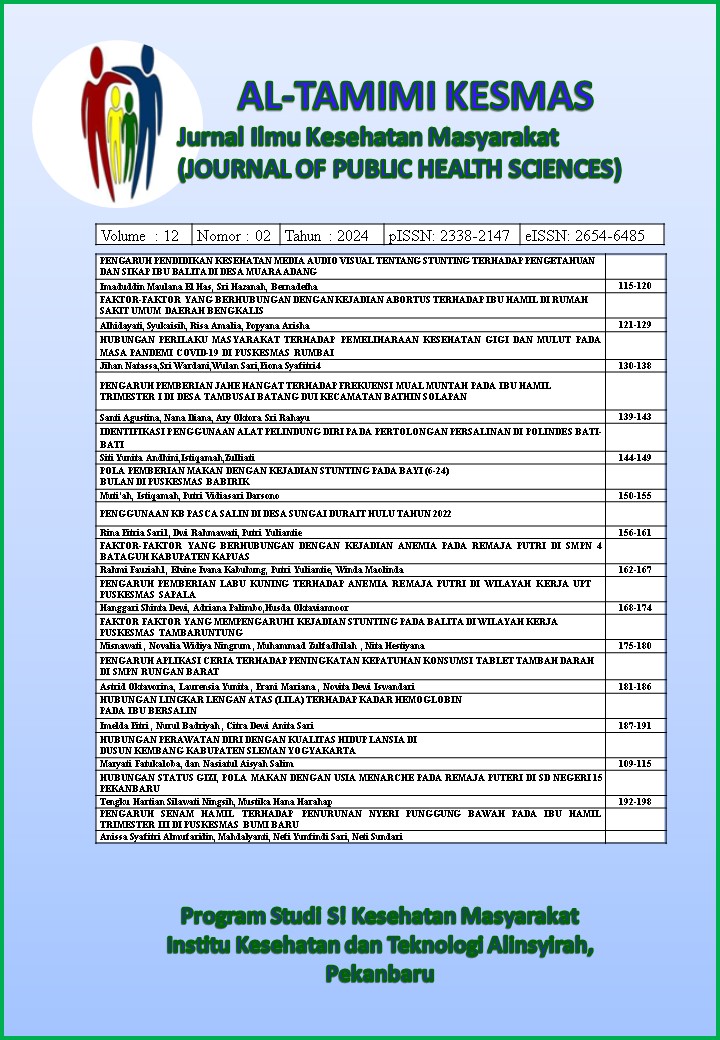FAKTOR FAKTOR YANG MEMPENGARUHI KEJADIAN STUNTING PADA BALITA DI WILAYAH KERJA PUSKESMAS TAMBARUNTUNG
DOI:
https://doi.org/10.35328/kesmas.v12i2.2510Abstract
The incidence of short toddlers or commonly known as stunting is one of the nutritional problems experienced by toddlers in the world today. Based on the South Kalimantan Provincial Service Report, the prevalence of stunting in South Kalimantan is still high, namely 33.08% of the 2018 Riskesdas results and is ranked eighth highest in the world. Indonesia. Meanwhile, Tapin Regency itself is ranked fifth with 36.04% of stunting incidents in South Kalimantan. This research aims to determine the factors that can influence the incidence of stunting in the Tambaruntung Tappin Tengah Health Center working area. The type of research chosen was analytical observational with a cross sectional design. The sample used was 89 children under five using simple random sampling, the research test used Chi square. From the research results, it was found that in 2023 it was 35.95%, exclusive breastfeeding 55.1% of respondents with good knowledge was 57.30% and children with KEK were 46.1%. Crosstabulation Chi-Square statistical analysis test p=0.000 can be concluded that there is an influence between maternal knowledge on the incidence of stunting in children under five in the working area of the Tambaruntung Health Center, Tapin Tengah District.
References
Ariyanti, S. (2015). Analisis Faktor Resiko Kejadian Stinting pada Anak Balita di Wilayah Kerja Puskesmas Muara Tiga Kabupaten Pidie. Universitas Diponegoro.
Kemenkes RI. (2018). Situasi Balita Pendek (Stunting ) di Indonesia, Pusat Data dan Informasi Kemenkes RI. Kementerian Kesehatan Republik Indonesia.
Mardiana. (2020). Hubungan Tingkat Pendidikan dan Pengetahuan Ibu Balita Dengan Angka Kejadian Stunting di Desa Secanggang Kabupaten Langkat. Universitas Muhammadiyah Sumatra Utara Medan.
Ramdhani, A., Handayani, H., & Setiawan, A. (2021). Hubungan Pengetahuan Ibu Dengan Kejadian Stunting . Prosiding Seminar Nasional LPPM UMP, 2, 28–35. https://semnaslppm.ump.ac.id/index.php/semnaslppm/article/view/122
Riskesdas. (2018). Hasil Utama Riskesdas 2018. In Kemenkes RI. Jakarta: Kemenkes RI.
Ruaida, N. (2018). Gerakan 1000 Hari Pertama Kehidupan Mencegah Terjadinya Stunting (Gizi Pendek) di Indonesia. Global Health Science, 3(1), 1–5. http://repo.poltekkes-maluku.ac.id/id/eprint/38/1/Gerakan 1000 Hari Pertama Kehidupan Mencegah Terjadinya Stunting %28Gizi Pendek%29 di Indonesia.pdf
Salamung, N. (2021). Pengetahuan Ibu Tentang Pencegahan Stunting Pada Balita Di Kelurahan Tatura Utara Kota Palu. Pustaka Katulistiwa: Karya Tulis Ilmiah Keperawatan, 2(1), 44–49. https://journal.stik-ij.ac.id/index.php/Keperawatan/article/view/77
Sandjojo, E. P. (2017). Buku Saku Desa Dalam Penanganan Stunting . Kementrian Desa, Pembangunan Daerah Tertinggal dan Transmigrasi.
Sari, I., & Sapitri, A. (2021). Pemeriksaan Status Gizi Pada Ibu Hamil Sebagai Upaya Mendeteksi Dini Kurang Energi Kronik (KEK). Jurnal Kebidanan Indonesia, 12(1), 1–5. https://doi.org/10.36419/jki.v12i1.434
Downloads
Published
Issue
Section
License
Copyright (c) 2024 Al-Tamimi Kesmas: Jurnal Ilmu Kesehatan Masyarakat (Journal of Public Health Sciences)

This work is licensed under a Creative Commons Attribution 4.0 International License.














